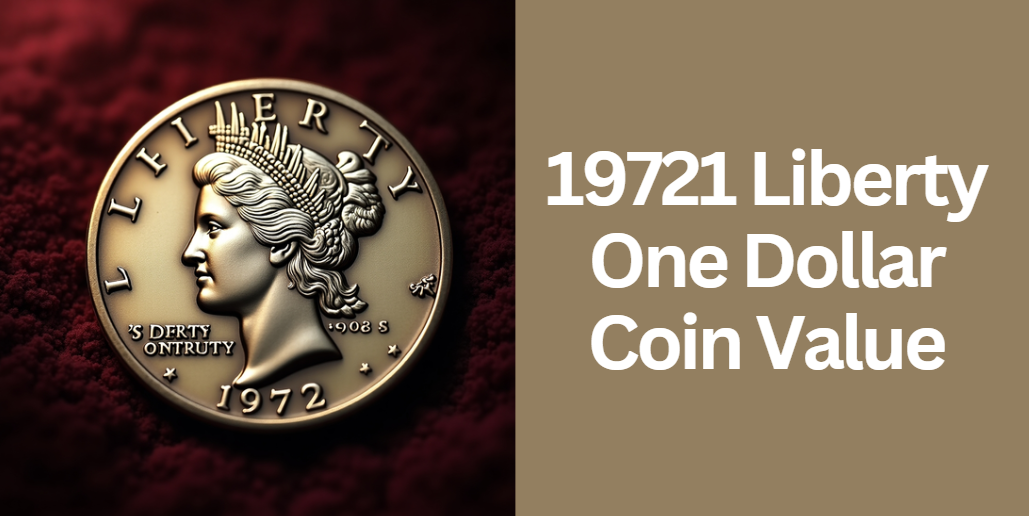The 19721 Liberty One Dollar Coin is a fascinating piece of American history. Designed during a time of significant cultural and economic change, this coin not only represents the legacy of American liberty but also serves as a collectible item with a value that can vary greatly based on several factors.
In this guide, you will learn about the historical context of the coin, its design details, different varieties, grading methods, and current market trends. Our aim is to offer you an unrivaled resource that covers every nuance of the 19721 Liberty One Dollar Coin Value.
Historical Background
In 1972, the United States minted a one-dollar coin that quickly became a subject of interest among collectors. This coin was produced during a period of change and innovation in American coinage, reflecting the country’s enduring commitment to liberty and progress.
The coin was designed to honor the ideals represented by the word “LIBERTY,” which has been a defining feature on U.S. currency for centuries. Its release coincided with a dynamic economic period, making it both a functional piece of currency and a valuable collectible.
Historically, the one-dollar coin played an important role in the monetary system, and its production was influenced by political and cultural trends of the time. Compared to other coins from the same era, the 19721 Liberty One Dollar Coin stands out due to its unique design and the evolving minting processes that were employed. This historical context is essential in understanding why its value has remained significant over the years.
Coin Design and Technical Specifications
Detailed Design Elements
The design of the 19721 Liberty One Dollar Coin is both symbolic and meticulously crafted. The obverse of the coin features a portrait, typically representing a notable American figure, accompanied by the inscriptions “LIBERTY” and “IN GOD WE TRUST.”
The reverse usually displays an eagle or another patriotic symbol, paired with the denomination “ONE DOLLAR” and other design elements that celebrate American heritage.
Technical Specifications
Understanding the coin’s technical aspects is crucial in evaluating its 19721 Liberty One Dollar Coin Value. Below is a table summarizing its key specifications:
| Specification | Details |
|---|---|
| Year of Issue | 1972 |
| Denomination | One Dollar |
| Material Composition | Copper-Nickel Clad or 40% Silver |
| Diameter | Approximately 38.10 – 38.50 mm |
| Weight | Around 22.68 – 24.60 grams |
| Mint Marks | Philadelphia, Denver, or San Francisco |
These technical details not only help in authenticating the coin but also play a significant role in determining its market value.
Varieties and Rarity Factors
The 19721 Liberty One Dollar Coin Value can vary dramatically based on the coin’s variety and rarity. The coin was produced in different compositions, with the majority being copper-nickel clad and a limited number of 40% silver versions, which are especially prized by collectors.
Varieties Explained
- Copper-Nickel Clad Versions: These are the most common and usually have a lower market value, often just above face value.
- 40% Silver Versions: These coins are marked with an “S” mintmark and are highly sought after, especially in proof or uncirculated conditions.
- Design Varieties: In some cases, subtle differences in the reverse design—such as the configuration of the eagle or the style of the inscriptions—can categorize the coin into different types (Type 1, Type 2, and Type 3). Among these, certain types (for example, Type 2) are much rarer and can command premium prices.
Rarity and Mintage Data
The rarity of the coin is largely determined by its mintage figures and the distribution of different varieties. Coins with lower mintage numbers or unique design errors are especially valuable. Collectors often refer to detailed mintage data and historical records to assess how scarce a particular variety is in the market.
Grading and Authentication
One of the most critical aspects of determining the 19721 Liberty One Dollar Coin Value is its condition. Coin grading is a standardized process that evaluates a coin’s preservation state, ranging from heavily circulated to pristine, uncirculated conditions.
Grading Scales
Coins are typically graded on a scale from MS (Mint State) to AU (About Uncirculated) and even to higher grades like Choice or Superior. The higher the grade, the more valuable the coin tends to be. For example, a coin graded MS66 or above might fetch significantly higher prices than one in average circulated condition.
Authentication Process
To ensure authenticity and avoid counterfeits, it is advisable to have the coin evaluated by reputable grading services such as PCGS, NGC, or CAC. The authentication process includes a thorough examination of the coin’s details, mint marks, and overall quality.
This verification is essential for both buying and selling, as it guarantees that the coin meets the standards required by serious collectors.
Identifying Counterfeits
Counterfeit coins can often be identified by examining specific design details, irregularities in the inscriptions, or variations in metal composition. Collectors should pay close attention to the following list when authenticating:
- Mint Mark Consistency
- Design Sharpness and Clarity
- Weight and Diameter Measurements
- Overall Condition and Eye Appeal
Factors Influencing Coin Value
Several factors determine the 19721 Liberty One Dollar Coin Value, and understanding these can help you make informed decisions whether you are buying, selling, or investing.
Condition and Preservation
The physical condition of the coin is one of the most significant value drivers. Coins that have been well-preserved, with minimal wear and no damage, are highly prized. In some cases, coins that come in their original packaging or with documented provenance are even more valuable.
Market Demand and Economic Trends
The overall demand for collectible coins can fluctuate with changes in economic conditions and collector interest. When the precious metals market is strong, or when there is heightened interest in historical artifacts, the 19721 Liberty One Dollar Coin Value may experience a premium. Additionally, auction results and recent sales data can offer insight into current market trends.
Historical and Numismatic Significance
The coin’s historical context and its significance in American numismatics also add to its value. A coin that represents a pivotal moment in history or has unique design elements can become a coveted piece for both collectors and investors.
Market Analysis and Current Valuation Trends
Recent market analysis shows that the 19721 Liberty One Dollar Coin Value varies based on its type, grade, and market conditions. Auction results from reputable sources have shown a wide range in prices—from coins that sell just above face value to rare, high-grade specimens that have achieved impressive prices.
Price Guides and Auction Data
A detailed look at auction data reveals that:
- Common circulated coins might sell for approximately $1 to $5.
- The 40% silver versions or coins with an “S” mintmark can range from $12 to $14 in lower grades.
- Rare varieties, especially those with higher grades or unique design attributes, can fetch premiums ranging from $80 to several hundred dollars, and in exceptional cases, even thousands of dollars.
Expert Opinions and Forecasts
Interviews with numismatic experts suggest that as the coin market evolves, the demand for high-quality, rare specimens is expected to grow. Experts emphasize that collecting coins in excellent condition and obtaining professional grading can significantly enhance the coin’s value over time.
Buying, Selling and Investing Tips
For collectors and investors, understanding how to navigate the market is key to maximizing the 19721 Liberty One Dollar Coin Value.
Where to Buy and Sell
It is important to transact with trusted dealers, reputable auction houses, and verified online marketplaces. Here is a brief list of suggested platforms:
- Established coin shows and auctions.
- Reputable dealers with a long history in numismatics.
- Verified online marketplaces like eBay, where you can check seller ratings and past sale prices.
Investment Considerations
When considering this coin as an investment, it is wise to adopt a long-term perspective. Diversifying your portfolio and understanding market cycles are critical. Additionally, always have your coins professionally graded and authenticated before making significant transactions.
Maintenance and Storage
Proper care and storage are essential for preserving the coin’s condition. It is advisable to store coins in protective holders, consider insurance for valuable items, and maintain records of purchase and grading reports. A simple maintenance checklist might include:
- Keeping the coin in a secure, climate-controlled environment.
- Avoiding frequent handling to prevent wear.
- Periodically reviewing the coin’s condition with a professional.
Glossary of Numismatic Terms
To aid your understanding, here are some key terms:
- Mint Mark: A letter indicating the mint where the coin was produced.
- Grading: The process of evaluating the coin’s condition.
- Proof Coin: A coin struck with special dies for collectors, usually with a mirror-like finish.
- Die Variety: Differences in the coin’s design that occur due to the use of different dies during minting.
For more detailed definitions and explanations, readers are encouraged to explore additional resources and numismatic literature.
FAQ’s About 19721 Liberty One Dollar Coin Value
1: What Are Some Notable Auction Records for the 19721 Liberty One Dollar Coin?
Recent auction data has shown that rare, high-grade specimens of the coin have achieved remarkable sale prices, often setting records that reflect their status as a premium collectible. While general market trends can vary, specific auction events have highlighted instances where exceptional examples, particularly in pristine condition, have garnered impressive bids. For collectors, these auction records serve as benchmarks for the coin’s potential as an investment.
2: How Does Provenance or Previous Ownership Impact the Coin’s Collectibility?
Provenance plays a crucial role in the collectible market. A well-documented history of previous ownership—especially if the coin was once part of a renowned collection—can enhance its desirability. Collectors often pay a premium for coins with verifiable backgrounds or stories that add historical and emotional value beyond the physical attributes of the coin.
3: What External Resources Can Help Me Deepen My Understanding of American Coin Collecting?
For those looking to further educate themselves, numerous books, online forums, and dedicated websites exist. Publications by recognized numismatic experts and memberships in coin collector associations can provide in-depth knowledge. Additionally, websites that offer regular market updates, grading standards, and discussion boards allow collectors to exchange insights and experiences about coins like the 19721 Liberty One Dollar Coin.
4: Can Technological Tools Assist in the Authentication Process of This Coin?
Yes, modern technology is increasingly being used in coin authentication. High-resolution imaging, 3D scanning, and even artificial intelligence-driven pattern recognition systems are now available to help verify a coin’s authenticity. These tools can detect minute details and subtle discrepancies, offering a reliable supplement to traditional grading services and enhancing confidence in the coin’s legitimacy.
5: Are There Any Upcoming Coin Shows or Events Where I Can See the 19721 Liberty One Dollar Coin Featured?
Coin shows, auctions, and numismatic events are regularly scheduled throughout the year in various regions. These events provide opportunities not only to view rare coins like the 19721 Liberty One Dollar Coin but also to network with experienced collectors, dealers, and grading professionals. Checking with local coin clubs, national coin associations, or industry websites can offer up-to-date information on when and where these events are taking place.
Conclusion
In summary, the 19721 Liberty One Dollar Coin Value is determined by a complex interplay of historical significance, design quality, rarity, condition, and market demand. This comprehensive guide has provided a detailed overview of everything from the coin’s history and design to grading standards and current market trends.
By understanding these factors, collectors and investors can make more informed decisions and potentially capitalize on this fascinating aspect of American numismatics. We hope this guide serves as your go-to resource for all things related to the 19721 Liberty One Dollar Coin.
Thank you for reading our detailed guide. If you found this information useful, please consider sharing it with fellow collectors and investors, and stay updated by subscribing to our newsletter for the latest insights in the world of coins.
More Posts
How Long Does Bottle Of Jyrre Take? – The Ultimate Guide
Eliza J Ej4m6753: The Definitive Guide to a Timeless Fashion Statement
In-Depth Guide to 2023 J J Yeley Jungle Jaw
Comprehensive Guide to the Connector Yazaki 7283-8497-90 2P 1.5 2P 9.5 WP Hybrid


